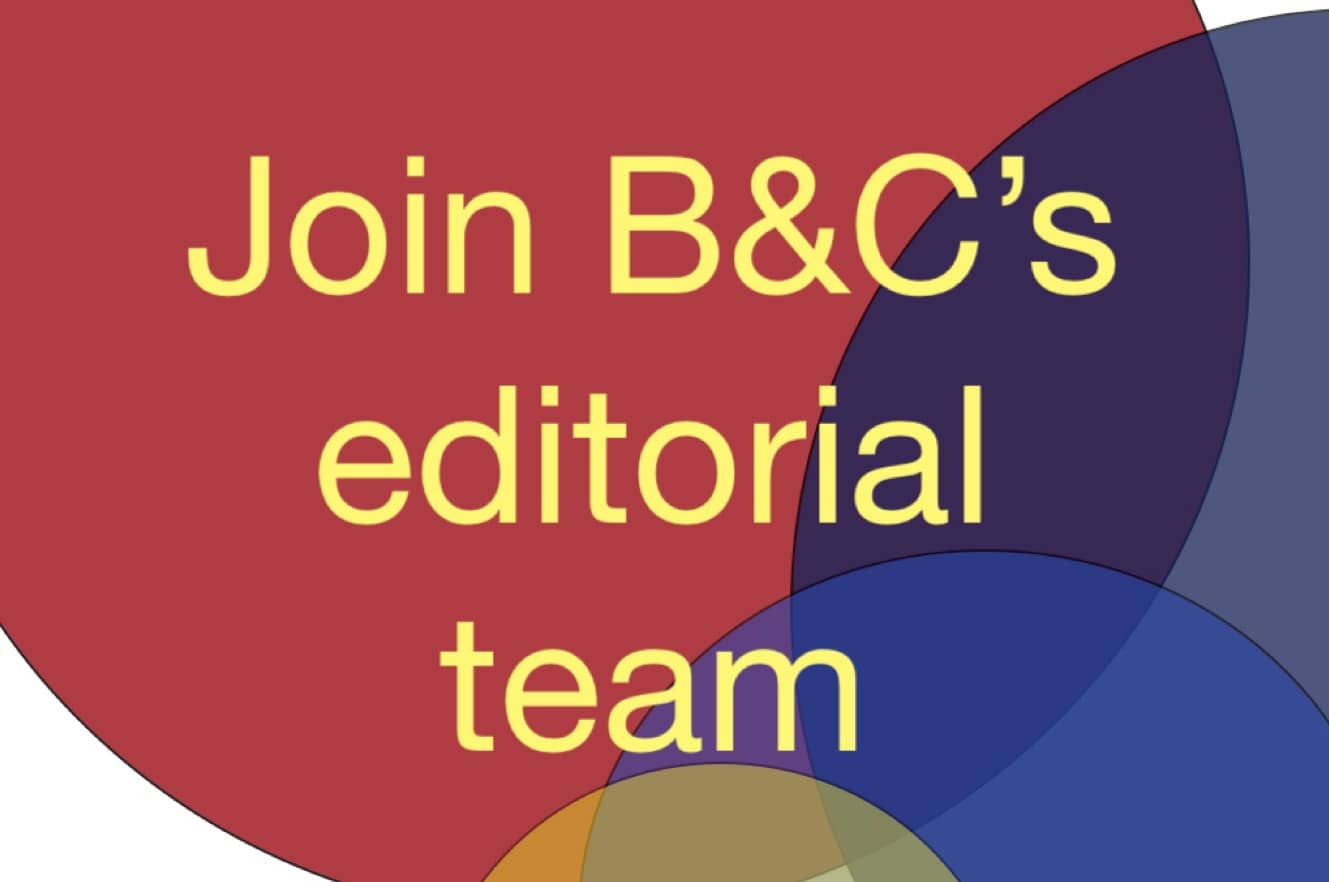
www.buildingsandcities.org/insights/news/new-editorial-positions.html
New Editorial Positions at B&C

We are seeking 2 people to journal our editorial team
Buildings & Cities journal is looking for 2 new Associate Editors to join our outstanding editorial team and to support the journal's mission. One role would specifically handle its communications through social media and the other role would oversee its "Commentaries" and "Research Pathways" initiatives. The commitment for each would be 3 hours per week. The Associate Editors will work in close cooperation with other B&C Editors.
The Roles
The Communications Editor post would entail (1) creating and developing a LinkedIn profile for the journal along with suitable content (Calls for Papers, Special Issues, Events, highlighting research papers' content) and (2) creating content for our lively Twitter account based on our publications and activities: @BuildingsCities
The Commentaries Editor post will entail (1) developing, (2) identifying and commissioning suitable authors and then (3) editing their manuscripts to create a series of Commentaries and Research Pathways essays for our website.
Selection Criteria
• A strong
understanding of built environment research
issues
• Research
experience (PhD or equivalent)
• Academic
writing and publication experience
• Ability
to synthesize information succinctly and clearly
•
Excellent communication skills
• Excellent
teamworking abilities and willingness to contribute to collaborative
decision-making processes
• Web
authoring skills (desirable)
• Editing
experience (desirable)
How to Apply
Please submit (1) a CV, (2) a cover letter highlighting which role(s) you are applying for together with your relevant experience and skills, (3) two relevant samples of your writing aimed at engagement with different audiences and (4) two references to:
Closing date: 15 March 2022.
Shortlisted applicants will be asked to make a short 5-minute presentation about their strategy and skills for the journal and the post(s) they are applying for.
About Us
Buildings & Cities is an independent and not-for-profit journal. It has rapidly established itself as a cutting edge home for quality research on the built environment. In addition to being a peer-review journal, we provide an intellectual space for engagement between researchers, practitioners and policy makers. Our actions are underpinned by our values and commitments found in our Key Principles. The scope of the journal is defined in our Aims & Scope.
Buildings & Cities is a highly dynamic, transdisciplinary built environment journal. It actively promotes excellence in research, two-way dialogue with the end users of this research and actively works to support early career researchers. The journal publishes peer reviewed scholarship (https://journal-buildingscities.org/ ) as well as news, commentaries, feedback on special issues and book reviews (https://www.buildingsandcities.org/)
Our editorial team is united by a mission to deliver world-class peer-reviewed quality research and provide clear reliable and usable information to the 'end users' of research. We encourage research that responds to societal demands and capabilities.
We seek to recruit and appoint the best talent regardless of age, sex, gender identity, ethnicity, disability, socio-economic background, religion and/or belief.
What's in it for You?
These are two intellectually stimulating and demanding roles that are vital for quality publishing today. Each role will expand your international networks, your international profile and provide a broad overview of emerging issues and research. Working within a friendly, small, highly experienced, editorial team, this is an opportunity to expand your knowledge as well as writing and dissemination skills.
You will be involved in engagement with academics, practitioners and users in the built environment, including exposure to networks of scholars, our international editorial board and practitioner panel. You will promote the dissemination and discussion of research findings.
These part-time roles should be considered as a service to the research and wider built environment community and an opportunity to enhance and further develop a personal research career. The posts are not remunerative. It is anticipated that each role will require 3 hours a week on average. Applicants may receive support from their academic institution for their time commitment in this role as career development and/or community service.
Our Values
In addition to the journal's Aims & Scope, our actions are underpinned by our values and commitments:
- We seek to publish highest quality research that has been evaluated through a fair, rigorous and robust peer-review process.
- Encourage and publish research and ideas that help improve the built environment, not just describe it.
- Maintain integrity in all our work with authors and oblige them to undertake and present their work according to ethical research and publishing guidelines. We are truthful, accurate, ethical and unbiased.
- Make all research articles in the journal freely available (open access).
- Translate: make the research accessible not only for academics and researchers, but also for the end-users of research: policymakers, practitioners, clients, teachers and occupants.
- Inspire and engage: promote dialogue and greater understanding between authors and the end-users of research, to have greater impact through discussions in virtual and live events.
- Create an inclusive and supportive community of authors, and assist those without funding to publish in our journal.
- Operate as a not-for-profit, reinvesting any surplus funds into the journal and the research community that we serve.
- Be independent: our role and content are independent of the interests of any organisation, institution, company or government.
- We are inclusive: valuing different perspectives and experiences of researchers, academics and practitioners from around the world. We support authors in the Global South.
Latest Peer-Reviewed Journal Content
Acceptability of sufficiency consumption policies by Finnish households
E Nuorivaara & S Ahvenharju
Key factors for revitalising heritage buildings through adaptive reuse
É Savoie, J P Sapinski & A-M Laroche
Cooler streets for a cycleable city: assessing policy alignment
C Tang & J Bush
Understanding the embodied carbon credentials of modern methods of construction
R O'Hegarty, A McCarthy, J O'Hagan, T Thanapornpakornsin, S Raffoul & O Kinnane
The changing typology of urban apartment buildings in Aurinkolahti
S Meriläinen & A Tervo
Embodied climate impacts in urban development: a neighbourhood case study
S Sjökvist, N Francart, M Balouktsi & H Birgisdottir
Environmental effects of urban wind energy harvesting: a review
I Tsionas, M laguno-Munitxa & A Stephan
Office environment and employee differences by company health management certification
S Arata, M Sugiuchi, T Ikaga, Y Shiraishi, T Hayashi, S Ando & S Kawakubo
Spatiotemporal evaluation of embodied carbon in urban residential development
I Talvitie, A Amiri & S Junnila
Energy sufficiency in buildings and cities: current research, future directions [editorial]
M Sahakian, T Fawcett & S Darby
Sufficiency, consumption patterns and limits: a survey of French households
J Bouillet & C Grandclément
Health inequalities and indoor environments: research challenges and priorities [editorial]
M Ucci & A Mavrogianni
Operationalising energy sufficiency for low-carbon built environments in urbanising India
A B Lall & G Sethi
Promoting practices of sufficiency: reprogramming resource-intensive material arrangements
T H Christensen, L K Aagaard, A K Juvik, C Samson & K Gram-Hanssen
Culture change in the UK construction industry: an anthropological perspective
I Tellam
Are people willing to share living space? Household preferences in Finland
E Ruokamo, E Kylkilahti, M Lettenmeier & A Toppinen
Towards urban LCA: examining densification alternatives for a residential neighbourhood
M Moisio, E Salmio, T Kaasalainen, S Huuhka, A Räsänen, J Lahdensivu, M Leppänen & P Kuula
A population-level framework to estimate unequal exposure to indoor heat and air pollution
R Cole, C H Simpson, L Ferguson, P Symonds, J Taylor, C Heaviside, P Murage, H L Macintyre, S Hajat, A Mavrogianni & M Davies
Finnish glazed balconies: residents' experience, wellbeing and use
L Jegard, R Castaño-Rosa, S Kilpeläinen & S Pelsmakers
Modelling Nigerian residential dwellings: bottom-up approach and scenario analysis
C C Nwagwu, S Akin & E G Hertwich
Mapping municipal land policies: applications of flexible zoning for densification
V Götze, J-D Gerber & M Jehling
Energy sufficiency and recognition justice: a study of household consumption
A Guilbert
Linking housing, socio-demographic, environmental and mental health data at scale
P Symonds, C H Simpson, G Petrou, L Ferguson, A Mavrogianni & M Davies
Measuring health inequities due to housing characteristics
K Govertsen & M Kane
Provide or prevent? Exploring sufficiency imaginaries within Danish systems of provision
L K Aagaard & T H Christensen
Imagining sufficiency through collective changes as satisfiers
O Moynat & M Sahakian
US urban land-use reform: a strategy for energy sufficiency
Z M Subin, J Lombardi, R Muralidharan, J Korn, J Malik, T Pullen, M Wei & T Hong
Mapping supply chains for energy retrofit
F Wade & Y Han
Operationalising building-related energy sufficiency measures in SMEs
I Fouiteh, J D Cabrera Santelices, A Susini & M K Patel
Promoting neighbourhood sharing: infrastructures of convenience and community
A Huber, H Heinrichs & M Jaeger-Erben
New insights into thermal comfort sufficiency in dwellings
G van Moeseke, D de Grave, A Anciaux, J Sobczak & G Wallenborn
'Rightsize': a housing design game for spatial and energy sufficiency
P Graham, P Nourian, E Warwick & M Gath-Morad
Implementing housing policies for a sufficient lifestyle
M Bagheri, L Roth, L Siebke, C Rohde & H-J Linke
The jobs of climate adaptation
T Denham, L Rickards & O Ajulo
Structural barriers to sufficiency: the contribution of research on elites
M Koch, K Emilsson, J Lee & H Johansson
Disrupting the imaginaries of urban action to deliver just adaptation [editorial]
V Castán-Broto, M Olazabal & G Ziervogel
Nature for resilience reconfigured: global- to-local translation of frames in Africa
K Rochell, H Bulkeley & H Runhaar
How hegemonic discourses of sustainability influence urban climate action
V Castán Broto, L Westman & P Huang
Fabric first: is it still the right approach?
N Eyre, T Fawcett, M Topouzi, G Killip, T Oreszczyn, K Jenkinson & J Rosenow
Social value of the built environment [editorial]
F Samuel & K Watson
Understanding demolition [editorial]
S Huuhka
Data politics in the built environment [editorial]
A Karvonen & T Hargreaves



Latest Commentaries
Decolonising Cities: The Role of Street Naming
During colonialisation, street names were drawn from historical and societal contexts of the colonisers. Street nomenclature deployed by colonial administrators has a role in legitimising historical narratives and decentring local languages, cultures and heritage. Buyana Kareem examines street renaming as an important element of decolonisation.
Integrating Nature into Cities
Increasing vegetation and green and blue spaces in cities can support both climate change mitigation and adaptation goals, while also enhancing biodiversity and ecological health. Maibritt Pedersen Zari (Auckland University of Technology) explains why nature-based solutions (NbS) must be a vital part of urban planning and design.